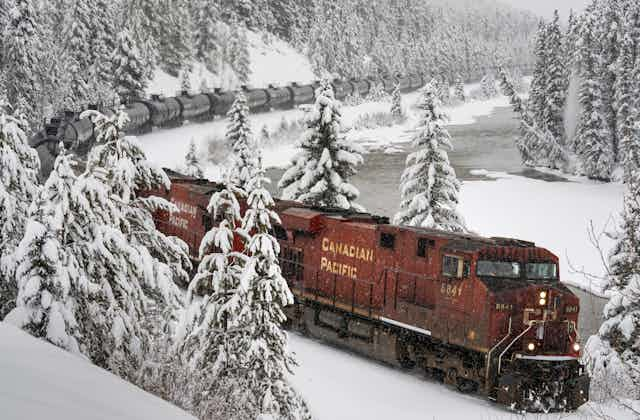Major wars are often watershed moments in history. Their outcomes define governance structures, politics and policy directions for decades, even centuries, to come. Russia’s invasion of Ukraine already seems certain to have these kinds of effects at the national, regional and global scales.
The invasion has quickly come to dominate political and policy agendas, displacing the focus from the COVID-19 pandemic and climate change. But the war in Ukraine will have major implications for these questions, particularly around energy and climate change, for Canada and the rest of the world, far into the future.
Beyond the immediate horror of Russia’s assault on Ukraine, perhaps its most obvious effects in climate and energy policy terms have been to provide Europe with a powerful imperative to accelerate the process of decarbonizing its economies.
The risks associated with European dependence on Russian oil and gas have always been an underlying rationale for energy transitions in Europe. A ban on Russian oil and gas imports, a significant portion of Europe’s energy supplies, may be one of the few measures left, short of direct military action, that could cause Putin to pause his attack.
While Canada faces no immediate threat to its energy security, it will likely face pressure to expand its role as a geopolitically stable and secure source of fossil fuels, reinforced by the economic opportunities offered by rising oil and natural gas prices. These developments could present significant challenges for Canada’s current efforts to reduce its greenhouse gas emissions by at least 40 per cent relative to 2005 by 2030 and reaching net-zero emissions by 2050.
Not sure on nuclear
Europe stands to see further increases in energy prices and potential shortages if it cuts off Russian oil and gas. But there is already strengthened interest in renewables, energy storage and other technologies that reduce Europe’s dependence on fossil fuels for space heating, transportation, industry and electricity generation.
There might also be renewed interest in nuclear energy, but that path is far from certain. The economics of new nuclear facilities remain profoundly unattractive even with massive governmental support.
In addition, Russia’s seizure of Chernobyl, its attack on the Zaporizhzhia nuclear plant and President Vladimir Putin’s thinly veiled nuclear threats have provided stark reminders of the security, safety and weapons proliferation risks associated with a nuclear-heavy pathway to decarbonization and energy security.
Pressure at home and abroad
For Canada, the implications of these developments are quite different. Prices for gasoline and other fuels have surged in response to concerns about global oil and gas supplies. Russia is the world’s second-largest crude oil producer, contributing about 13 per cent of world oil production in 2020.

Governments need to be vigilant around the possibilities of the old problem for war profiteering. The fuel now being sold at elevated prices was made from supplies bought and paid for long before Putin’s invasion. Russian oil is an utterly marginal element of Canada’s energy supply, and should be terminated immediately, as the United States is considering.
More likely, Canada will face both domestic and international pressures to expand its role as a secure source of fossil fuels for Western Europe and other consumers of Russian oil and gas. But moves to increase the country’s output of oil and natural gas will pose direct challenges to Canada’s existing climate change commitments and policies.
Canada’s current oil reserves are overwhelmingly concentrated in the western Canadian oilsands. Their extraction is highly energy and carbon intensive, and the federal government’s current climate policy trajectory is to move the upstream oil and gas sector towards net-zero emissions by 2050.
New export infrastructure
At the same time, there is currently no direct route for a major expansion of exports of Canadian oil to Europe. Additional exports would have to move through the U.S. Gulf Coast, but that option is now constrained by, among other things, President Joe Biden’s rejection of the Keystone XL pipeline.
The situation may lead to calls for new export infrastructure. There are already calls for the revival of the Alberta to New Brunswick Energy East pipeline — a pathway that could lead to renewed conflict between Québec and Alberta.

Canada’s conventional natural gas production has already been in decline, but the geopolitical situation and rising world prices may renew interest in British Columbia’s largely stalled liquid natural gas export initiatives. Such developments would further complicate the national climate policy landscape, as accessing B.C.’s gas resources would be highly carbon-intensive. Proposals may also re-emerge for LNG export facilities in Canada’s East Coast.
None of this could happen quickly enough to affect the immediate global energy security situation, and the economic viability of such projects would remain uncertain against the ongoing backdrop of widespread decarbonization in response to climate change.
Read more: What China's plans to decarbonize its economy mean for Canada's energy exports
The trajectory of Canada’s recent greenhouse gas emissions has already been drifting upwards, making the achievement of the federal government’s 2030 and 2050 goals increasingly difficult. The pressures to expand fossil fuel exports will deepen these challenges, even as the Intergovernmental Panel on Climate Change has again highlighted the growing impacts of a changing climate.
One potential positive aspect at this stage may be that the prospect of oil and gas prices remaining elevated for the long term will accelerate public interest in Canada’s own energy transition, particularly around electric vehicles.
The new relationships between energy, geopolitical security and climate change policy flowing from the invasion of Ukraine are only beginning to emerge. Their ultimate directions — along with the outcome of the war — remain uncertain, but the implications for Canada, particularly in terms of reconciling the goals of security, energy and climate change policy, may be enormous.

